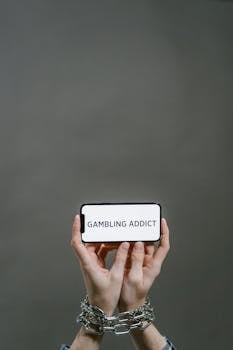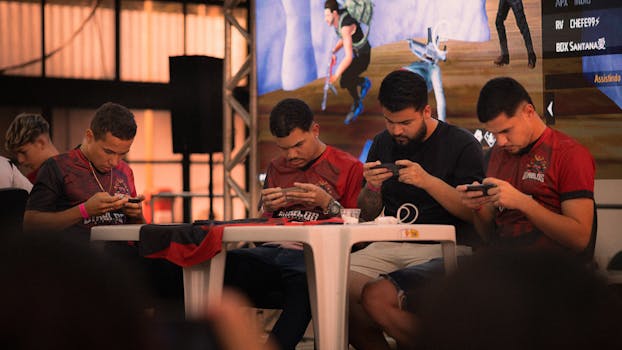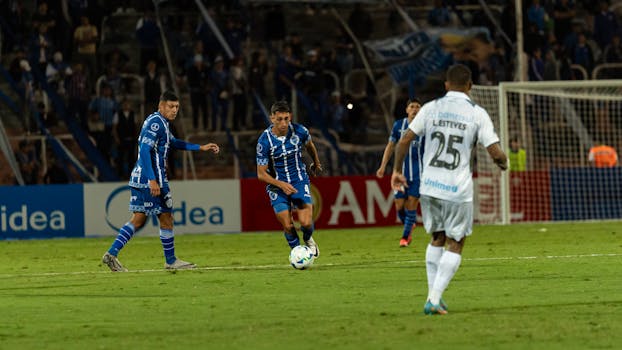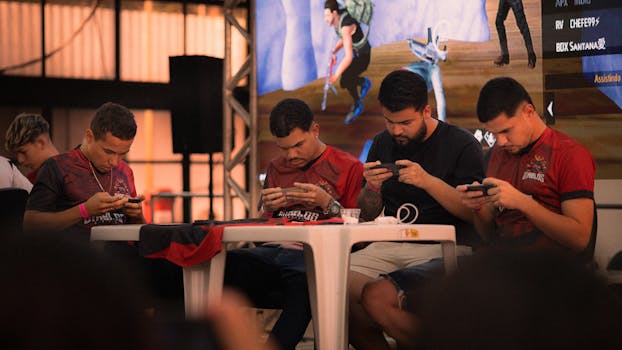eSports
How to Stand Out in the eSports World: Tips from Professionals
Want to elevate your mobile gaming career? Learn proven esports tips from professionals on gameplay habits, teamwork, branding, streaming, and building competitive resilience. Stand out and grow with these expert strategies.
Anuncios
Winning isn’t luck in mobile gaming and the wider eSports scene. Success means showing up differently from thousands of other competitors. When pros drop esports tips, they’re sharing the blueprint for career-changing moves on and off the screen.
Standing out in competitive gaming matters more than most realize. As the number of aspiring players grows, unique skills, clear routines, and distinctive branding form what separates standout competitors from the rest. Excellence gets noticed—and rewarded.
Below, discover how to sharpen your edge. Learn practical, professional esports tips to get noticed, improve faster, and make your mark in the world of mobile gaming. Start using these effective insights today.
Refining Gameplay Habits for Consistent Performance
Refining your gameplay habits yields consistent results, even during high-stress matches. Focusing on your routines helps you play without second-guessing and reduces split-second mistakes.
Esports tips for habit-building include tracking your warm-up, reviewing post-match footage, and maintaining a game-focused mindset. Regularly practicing these steps stabilizes your gameplay over time, creating the foundation of a standout player.
Designing Pre-Match Routines with Precision
Establishing a pre-game ritual—like finger stretches or set rounds in training mode—puts you in control. One player says, “I run my checklist: five headshot drills, water break, map quick-study.” This structure becomes a trigger for peak performance.
Consistency transforms ritual into muscle memory. When you follow your exact steps every session, nerves fade into a familiar rhythm. This practice, a core esports tip, ensures your hands and mind are match-ready as soon as the round starts.
The difference is clear: scattered preparation leads to inconsistent plays, while ritualized routines set a reliable baseline. Try adding a timed warm-up and checklist to your practice today.
Analyzing Mistakes for Fast Improvement
Top mobile gamers approach mistakes as learning cues. “After every loss, I replay my error, say it aloud, then rewrite my reaction,” shares one seasoned competitor. This step-by-step reflection speeds up improvement.
Use clip review tools or screen-record your matches, pausing to annotate what went wrong. Keep your feedback specific: “Reacted late to gank at 11:02, fix vision placement.” These targeted notes create a growing playbook of corrections.
Within weeks, active error analysis elevates your baseline skill level. It’s one of the most reliable esports tips for climbing leaderboards and building resilience after each setback.
| Gameplay Habit | Setup Example | When to Use | Key Benefit |
|---|---|---|---|
| Pre-match Warm-Up | 10 minutes of aim training | Before every ranked match | Reduces early-game jitters |
| Post-match Review | Clip review, note 2 mistakes | After every session | Identifies improvement areas |
| Goal-Setting | Set 3 priority skills/day | Start of week | Keeps practice focused |
| Feedback Loop | Peer/squad critique | Twice weekly | Unlocks blind spots |
| Break & Stretch | 5 min every hour | During long sessions | Prevents injury, tiredness |
Building Team Synergy and Communication Strategies
Ahead-of-time teamwork sets top squads apart. Mastering communication and synergy ensures fast, clear plays during mobile matches, and is a professional-grade esports tip in every high-tier game.
Pros use scripts and quick-call systems, so teammates know exactly what “Rotating B now” or “Hold—flank on three” means. Good communication eliminates wasted time and mental strain.
Implementing In-Game Call Shortcuts
Condense complex strategies into codewords everyone knows. Saying “Echo” might signal ambush, while “Orange” means change positions. Everyone on your team can react in sync, without confusion or lengthy explanations at crunch time.
Use practice to standardize which words trigger which behaviors. Have new members quizzed on your system to keep everything smooth under pressure. When everyone speaks a common language, your squad runs like a well-oiled machine.
- Design a glossary of team calls for each map or game mode. This helps clarity when nerves run high, and everybody instantly understands what to do next.
- Assign one person as lead caller per round. This concentrates decision-making, reducing hesitation from conflicting voices or overtalk.
- Set a rule for urgent silence: when the “urgent” call happens, everyone stops talking except the lead. This keeps vital calls audible.
- Record voice comms for review. Share snippets where the team moved perfectly—or missed a cue—then improve your scripts for next time.
- Rehearse time-sensitive plays with a stopwatch. Practice shaving a second off setups, just like relay drills, to create a real match edge.
Strong team communication is an applied esports tip that competitive teams revisit every season. Practice makes it second nature.
Strengthening Group Roles and Flexibility
Flexible role assignment increases your lineup’s adaptability on game day. Worksheet-style prep helps with quick role swaps if needed, and each member practices two backup positions per game as insurance.
Incorporate simulated emergencies into training: someone drops connection, or a meta shift demands lane switches. Debrief after each run to spot friction points, then refine who covers what job and when.
- Rotate everyone through key roles—tank, support, carry—so you aren’t caught off guard by bans or unexpected absences in tournaments.
- Create “backup call” scripts. If main shot-caller disconnects, backup instantly takes over with no drama. Preparation here stops panic crushing play later.
- Check if every person on the roster can communicate comfortably in their backup job. This ensures seamless swaps and quick adaptation, wins over rigid teams.
- Assign mini-challenges where subs fill in unexpectedly. Debrief what worked and adjust training protocols so everyone gets used to surprises.
- Assess role strengths monthly. Rank comfort and performance per slot, so the team always fields its highest potential lineup at every event.
Proactively cross-training and scripting transitions creates a winning advantage. Use this esports tip to unlock lineup resilience.
Sharpening Your Identity and Evolving a Personal Brand
Forging a unique play style, handle, or personal branding strategy is an esports tip pros use to attract both sponsors and fans. Tangible authenticity stands out even when skills are equal, and brands seek recognizable personalities in the mobile gaming world.
Professional players commit to consistent colors, logos, in-game avatar choices, and even meme-worthy catchphrases or victory dances to stay memorable after each match.
Developing a Distinct Play Signature
Your specific approach sets you apart. Some mobile gamers speed-run certain maps, making their attack style famous. Another draws attention with unusual hero picks or creative item builds, driving online chatter and buzz outside tournaments.
Track reactions: Did an opponent whisper that you “always push left” or “never miss a skill shot”? Collect feedback from others to finetune your signature and amplify what excites spectators.
Aim for consistency. If teammates or shoutcasters mention your unique choices multiple times, lock them in as your go-to style. Combined with solid esports tips, signature moves build fan recognition.
Using Social Platforms for Lasting Engagement
Share highlight reels, quick tactics, or candid behind-the-scenes looks of training to build audience trust. A pro says, “I show how I grind, not just wins—so new fans relate to my journey.” This transparency turns casual viewers into devoted followers.
Answer DMs and mention supporters in posts, reinforcing a sense of community. Post themed content around tournaments—fun polls, victory photos, or even mini-challenges—to keep fans returning and sharing with their own friends.
When you embed your personal journey and real lessons into social content, fans root for your growth, not just your rank. Use these esports tips to ignite organic follower growth.
Optimizing Mobile Equipment and In-Game Settings
Upgrading your mobile gear and refining settings delivers measurable improvements in reaction time, comfort, and overall consistency—just as essential as in-game skill. The right esports tips in this area can shave seconds off your play and keep injuries away.
Minimize lag, maximize responsiveness, and always adjust sound cues and haptic feedback for your device until gameplay feels like an extension of your hand, not a hurdle.
Customizing Controls and HUD for Precision
Adjust your button layouts, HUD positions, and sensitivity settings every season. Top competitors map key skills near natural reach for their fingers, reducing travel time by milliseconds.
Toggle colorblind mode or text size to spot enemies quickly, or reposition mini-maps near your thumb for instant information access. Custom tuning is a proven esports tip for microimprovement in clutch moments.
Test settings in solo queue, then get feedback from trusted practice partners. If your accuracy jumps in heated fights, lock that configuration for tournaments. Tiny tweaks often produce big win-rate gains.
Maintaining Physical Equipment Health and Comfort
Wipe device screens before each session—grease or dust overwhelms touch sensors, causing missed swipes. Use a stable surface and hand rest to reduce strain during marathon matches.
Invest in device coolers or grippy controller add-ons if device heat or slickness is an issue. Attention to ergonomic details keeps you playing at peak form even after hours of grinding.
Never ignore wrist, finger, or elbow fatigue. Add short stretch routines between rounds so physical pain never sabotages your next big moment—one of the most reliable esports tips for career longevity.
Leveling Up with Peer Feedback and Mini-Review Sessions
Inviting critical yet constructive feedback accelerates advancement. Scheduled mini-review sessions with trusted peers lead to rapid detection of blind spots, enabling steady improvement via actionable esports tips in real-time.
Emphasizing honesty, not just encouragement, ensures feedback covers minor slip-ups and habits before they turn into bigger problems in ranked play.
Establishing a Reliable Feedback Circle
Create a private group—maybe a shared server for your squad—devoted solely to reviewing gameplay. Everyone commits to uploading two clips per week for group discussion.
Use a simple script: “At 04:30 I overcommitted top, better path was…” so feedback stays focused and actionable. Limit comments to specifics that can be tried next session—not vague opinions.
After every feedback circle, list two changes to implement immediately. Over a month, track improvements and celebrate obvious gains. Regular review is a powerful, underused esports tip in mobile gaming advancement.
Adopting Peer-to-Peer Teaching Moments
Rotate the teaching role among members, letting each share their ‘one big lesson’ from recent matches. Whether it’s a sneaky ward spot or power item timing, this keeps learning collective, not just top-down.
Whenever debate sparks, pause the meeting and run a mock scenario: “Let’s test both decisions in solo mode right now.” Compare outcomes and adjust your normal playbook afterward—evidence beats theory every time.
Regular teaching raises team maturity and builds a culture where honest questions and improvement outpace ego. These types of esports tips make squads stronger for the next event.
Streaming and Content Creation with a Focus on Skill Growth
Grow your fanbase and personal skills by streaming with educational intent. Sharing live commentary while playing reveals thought processes, and challenges you to be transparent with both victories and mistakes.
Streaming with a focus on skill-building—even when things go sideways—turns casual viewers into loyal learners who return for every new tactic, a professional-grade esports tip for audience retention.
Balancing Entertainment with Informative Value
Mix play-by-play humor and quick breakdowns of smart plays. One streamer starts each session with, “Let’s review key map changes,” making viewers part of a mini-coaching group.
Highlight both wins and ‘teachable losses’ live, saying things like, “Here’s where I should’ve rotated sooner.” Your transparency reinforces skill-first credibility, attracting both new fans and sponsors looking for authenticity.
Combine quick tip overlays or infographics mid-stream, showing controller configs, map rotations, or burst combo timings. This makes each broadcast more valuable than just another gameplay montage.
Responding to Chat and Creating Feedback Loops
Prioritize answering gameplay-related chat questions as they come up. Pause the action, review a play, and provide deeper insights: “Here’s my mindset after that tower dive.”
Schedule weekly streams where viewers vote on which aspect you’ll practice or demo live: sniping, team fight mechanics, or micro-positioning. This collaborative direction ensures sustained viewer growth and evolving content value.
Set up polls after big matches. “What’s one move you’d want explained?” Use these answers for future tutorials—real-time fan input refines your content, another concrete esports tip.
Fostering Mental Toughness and Long-Term Resilience
Enhancing mental fortitude boosts competitive longevity. Routine practice of intentional breathing, self-talk, and active stress management is a core esports tip for maintaining composure under fire, not just in tournaments but in daily ranked play.
Consistency during win-loss cycles lets players bounce back faster and avoid emotional burnout, safeguarding both skill and passion for the long haul.
Using Short Reset Rituals After Each Loss
Reset rituals are quick, actionable. “After every defeat, I pause, do three deep breaths, rehydrate, and review one positive play,” a veteran shares. This routine interrupts tilt and reminds you of momentum moments.
Write a sticky note: “Reset & Refocus.” Place it near your play setup as a visual prompt after tough rounds. Seeing this, you perform the reset automatically—forging resilience and a non-tilting reputation among peers.
Consistent resets keep performance steady, a hallmark move in the montage of pro-level esports tips that serious mobile competitors adopt for the long term.
Setting Realistic Goals and Celebrating Small Wins
Goals must match your timeline and actual effort. Breaking season targets into weekly micro-goals makes them feel attainable and provides a constant sense of progress. Each time you tick one off, recognize the growth.
Share mini-masteries with your squad: “I landed five perfect flashes today,” or, “My comms hit perfect timing.” Small wins motivate both you and your practice circle—momentum compounds with every step.
Keeping a visible goal tracker next to your device keeps everyone focused and positive, even through plateau periods. It’s an esports tip pros consistently use to fuel confidence and endurance.
Crafting Your Competitive Legacy—One Step at a Time
The practical esports tips outlined above don’t just work—they define standout careers from amateurs to pros. Every habit, routine, and honest review builds toward a legacy of consistent growth in mobile gaming.
Applying team communications, identity-branding, equipment setups, streaming engagement, or resilience rituals, delivers measurable rewards that last beyond any single tournament. Being mindful and strategic at every stage ensures you’re memorable for skills and sportsmanship.
The eSports stage changes constantly, but one thing endures: professionals rise by refining daily details, experimenting with advice, and sticking with the esports tips that become their signature advantage over time.





